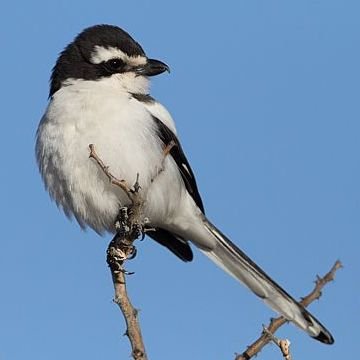Laniidae – Shrikes

Shrikes (/ʃraɪk/) are carnivorous passerine birds of the family Laniidae. The family is composed of 33 species in four genera.
The family name, and that of the largest genus, Lanius, is derived from the Latin word for “butcher”, and some shrikes are also known as butcherbirds because of their feeding habits. The common English name shrike is from Old English scrīc, alluding to the shrike’s shriek-like call.
Most shrike species have a Eurasian and African distribution, with just two breeding in North America (the loggerhead and great grey shrikes). No members of this family occur in South America or Australia, although one species reaches New Guinea. The shrikes vary in the extent of their ranges, with some species such as the great grey shrike ranging across the Northern Hemisphere to the Newton’s fiscal which is restricted to the island of São Tomé.
They inhabit open habitats, especially steppe and savannah. A few species of shrikes are forest dwellers, seldom occurring in open habitats. Some species breed in northern latitudes during the summer, then migrate to warmer climes for the winter.
Shrikes are medium-sized birds with grey, brown, or black and white plumage. Most species are between 16 cm (6.3 in) and 25 cm (9.8 in) in size, however, the genus Corvinella with its extremely elongated tail feathers may reach up to 50 cm (20 in) in length. Their beaks are hooked, like those of a bird of prey, reflecting their predatory nature, and their calls are strident.
Shrikes are known for their habit of catching insects and small vertebrates and impaling their bodies on thorns, the spikes on barbed-wire fences, or any available sharp point. This helps them to tear the flesh into smaller, more conveniently sized fragments, and serves as a cache so that the shrike can return to the uneaten portions at a later time.
Shrikes are territorial, and these territories are defended from other pairs. In migratory species, a breeding territory is defended in the breeding grounds and a smaller feeding territory is established during migration and in the wintering grounds.[3] Where several species of shrikes exist together, competition for territories can be intense.
Shrikes make regular use of exposed perch sites, where they adopt a conspicuous upright stance. These sites are used to watch for prey and to advertise their presence to rivals.
Most authorities agree that there are just 33 species of true Shrikes; they are:
Yellow-billed Shrike Corvinella corvina
Magpie Shrike Urolestes melanoleucus
Northern White-crowned Shrike Eurocephalus rueppelli
Southern White-crowned Shrike Eurocephalus anguitimens
Tiger Shrike Lanius tigrinus
Souza’s Shrike Lanius souzae
Bull-headed Shrike Lanius bucephalus
Brown Shrike Lanius cristatus
Red-backed Shrike Lanius collurio
Isabelline Shrike Lanius isabellinus
Red-tailed Shrike Lanius phoenicuroides
Burmese Shrike Lanius collurioides
Emin’s Shrike Lanius gubernator
Bay-backed Shrike Lanius vittatus
Long-tailed Shrike Lanius schach
Grey-backed Shrike Lanius tephronotus
Mountain Shrike Lanius validirostris
Mackinnon’s Shrike Lanius mackinnoni
Lesser Grey Shrike Lanius minor
Loggerhead Shrike Lanius ludovicianus
Great Grey Shrike Lanius excubitor
Southern Grey Shrike Lanius meridionalis
Steppe Grey Shrike Lanius pallidirostris
Chinese Grey Shrike Lanius sphenocercus
Grey-backed Fiscal Lanius excubitoroides
Long-tailed Fiscal Lanius cabanisi
Taita Fiscal Lanius dorsalis
Somali Fiscal Lanius somalicus
Common Fiscal Lanius collaris
Uhehe Fiscal Lanius marwitzi
Sao Tome Fiscal Lanius newtoni
Woodchat Shrike Lanius senator
Masked Shrike Lanius nubicus
-
Brown Shrike Lanius cristatus
WikipediaThe Brown Shrike (Lanius cristatus) is a bird in the shrike family that is found mainly in Asia. It is closely related to the Red-backed Shrike (L. collurio) and Isabelline Shrike (L. isabellinus). Like most other shrikes, it has a distinctive black "bandit-mask" through the eye…. -
Loggerhead Shrike Lanius ludovicianus
A small gray, black, and white bird of open areas, the Loggerhead Shrike hardly appears to be a predator. But it uses its hooked beak to kill insects, lizards, mice, and birds, and then impales them on thorns to hold them while it rips them apart…. -
Northern White-crowned Shrike Eurocephalus rueppellii
Species AccountSound archive and distribution map -
Northern White-crowned Shrike Eurocephalus rueppellii
Species AccountThe northern white-crowned shrike or white-rumped shrike (Eurocephalus ruppelli), is a shrike found in dry thornbush, semi-desert, and open acacia woodland in east Africa from south eastern South Sudan and southern Ethiopia to Tanzania. Its binomial name commemorates the German naturalist and explorer Eduard Rüppell. -
Northern White-crowned Shrike Eurocephalus ruppelli
BirdLife Species Account -
Red-backed Shrike Lanius collurio
ed-backed shrikes are slightly larger, but slimmer, than house sparrows. The male is unmistakable with a bluish-grey head, black mask, bright chestnut back and thick hooked black bill… -
Southern Fiscal Lanius collaris
Species AccountSound archive and distribution map. -
Southern Fiscal Lanius collaris
Species AccountThe southern fiscal or fiscal shrike (Lanius collaris) is a member of the shrike family found through most of Sub-Saharan Africa.
-
Number of bird species: 33
-
Shrikes - A Guide to the Shrikes of the World
| By Norbert Lefranc & Tim Worfolk | Pica Press | 2000 | Hardback | 192 pages, 16 colour plates, illustrations, maps | ISBN: 9781873403471 Buy this book from NHBS.com -
Shrikes and Bush-Shrikes
| (Including Wood-Shrikes, Helmet-Shrikes, Flycatcher-Shrikes, Philentomas, Batises and Wattle-Eyes) | by Tony Harris & Kim Franklin | Christopher Helm | 2000 | Hardback | 392 pages, 41 colour plates, line illustrations, 114 maps | ISBN: 9780713638615 Buy this book from NHBS.com -
The True Shrikes (Laniidae) of the World
| (Ecology, Behaviour and Evolution) | by EN Panov | Pensoft Publishers | 2011 | Hardback | 910 pages, Colour plates, colour & b/w figures, maps, tables | ISBN: 9789546425768 Buy this book from NHBS.com
-
Shrikeology
Mailing ListSHRIKEOLOGY is the discussion group for all the lovers of shrikes…
